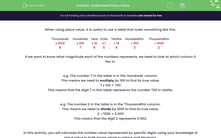When using place value, it is useful to use a table that looks something like this:
| Thousands | Hundreds | Tens | Units | . | Tenths | Hundredths | Thousandths |
| x 1000 | x 100 | x 10 | x 1 | . | ÷ 10 | ÷ 100 | ÷ 1000 |
| 8 | 7 | 6 | 5 | . | 4 | 3 | 2 |
If we want to know what magnitude each of the numbers represents, we need to look at which column it lies in.
e.g. The number 7 in the table is in the 'Hundreds' column.
This means we need to multiply by 100 to find its true value.
7 x 100 = 700
This means that the digit 7 in this table represents the number 700 in reality.
e.g. The number 2 in the table is in the 'Thousandths' column.
This means we need to divide by 1000 to find its true value.
2 ÷ 1000 = 0.002
This means that the digit 2 represents 0.002.
In this activity, you will calculate the number value represented by specific digits using your knowledge of place value in both larger whole numbers and decimals.
Let's get going!








